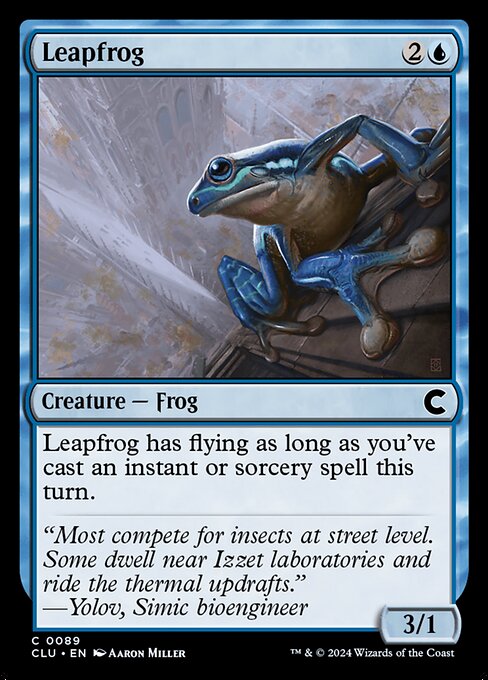
Image courtesy of Scryfall.com
Art reinterpretations in Secret Lair releases: Leapfrog as a case study
Secret Lair has long been a playground for Magic: The Gathering fans who crave a bit of bold, alternative storytelling wedded to card art. The concept is simple and deliciously mischievous: take a familiar card, reimagine its visuals, and let the flavor of a different artist or a new theme breathe fresh life into a staple. When you look at Leapfrog from Ravnica: Clue Edition through this lens, you see how a blue creature’s aesthetic can swing dramatically—without altering a single line of its rules text. 🧙🔥💎
Leapfrog is a blue creature—a Frog—casting a spell-laced aura around tempo and trickery. For a mana cost of {2}{U}, it shows up as a 3/1 on the battlefield, which is a handy stat line for a common creature in a set that prized cleverness and gambits. Its trick is subtle but potent: “This creature has flying as long as you’ve cast an instant or sorcery spell this turn.” That conditional flight mirrors the clever, on-the-fly gambits of a blue deck, where you might cast a cantrip here or sling a cheap spell there to tilt the tempo in your favor. It’s the kind of mechanic that rewards planning and spontaneity in equal measure, a perfect canvas for art that revels in fly-by-night misdirection. ⚔️🎲
A look at the art and artistial intent
Leapfrog’s art, illustrated by Aaron Miller for the CLU (Ravnica: Clue Edition) printing, sits at an intersection of whimsical amphibian science and the bustling energy of urban guild life. The Simic-aligned flavor in the set’s lore—Simic Combine’s tinkering with nature and evolution—lends itself to art that looks like a field notebook left open in a laboratory: wet glass, glimmering hues, and a sense of movement that makes you feel the frog’s leaps as much as its flight. The flavor text—“Most compete for insects at street level. Some dwell near Izzet laboratories and ride the thermal updrafts.”—invites us to picture Leapfrog as more than a creature; it’s a tiny dynamic in a city of wonder and experiments. That line also anchors the card in a broader MTG universe where art is not just decoration but a doorway into the worldbuilding you love. 🎨🧙♂️
“Most compete for insects at street level. Some dwell near Izzet laboratories and ride the thermal updrafts.” — Yolov, Simic bioengineer
Secret Lair reimaginings often lean into that sense of doorway—opening a window into what a card could be if a different imagination took the reins. Leapfrog, in the Secret Lair frame, could be presented with shimmering, neon-blue bio-creatures swapping the classic ink lines for luminous plasmatic trails, or it could arrive in a style that foregrounds street-art vibes, urban geometry, or even a playful pastel palette. The point isn’t to change what the card does; it’s to change how we perceive its impact on the board and on our memory of the card’s place in MTG history. This art-forward approach is part of what makes Secret Lair a lively conversation starter among both new players and seasoned collectors. 🧙♀️💎
What art reinterpretations mean for collectors and players
- Preservation of mechanics, celebration of visuals: The Leapfrog card text remains the same, so you can count on the flight mechanic while enjoying an alternate aesthetic. This duality is the charm of Secret Lair in a nutshell: homage to the original, signature twist on the surface. 🧭
- Rarity and reprint dynamics: Leapfrog in CLU is a common, non-foil print with a modest market presence (USD around 0.15, EUR around 0.19). Secret Lair variants often create collectible conversation pieces that may appreciate as a gallery of MTG art, even if the card’s tournament value stays modest. This is the kind of juxtaposition that fans savor: a card you can play and a piece you can collect. 💎
- Art as a storytelling tool: Each reinterpretation becomes a mini-narrative: what if Leapfrog’s world was more laboratory-charged, or more street-smart, or more painterly and abstract? The art choice colors your perception of tempo, flight, and the cunning that blue magic often embodies. 🎨
- Flavor text as a bridge: The CLU flavor text anchors Leapfrog to Simic bioengineering and urban experimentation—perfect fuel for discussions about how different art styles reinterpret the same lines of text. It’s a reminder that art and lore sit side by side, enriching both. 🧪
- Gameplay considerations in casual play: Even with a different aesthetic, Leapfrog’s tempo-game strength shines when you pair it with instant and sorcery spam—think cantrips and quick spells that push this little frog into a fleeting flight window. It’s a fun puzzle for deck builders who love blue’s timing discipline and the thrill of a well-timed evasive threat. ⚔️
Connecting Secret Lair to the broader MTG culture
Secret Lair isn’t just about pretty pictures; it’s a cultural crossroads. It invites artists who bring their own voices into Magic’s evergreen engine, offering fans a way to collect, discuss, and display their love for the game in new and personal ways. Leapfrog serves as a microcosm of that philosophy: a familiar creature, a familiar trick, and a fresh sight line that makes you grin at the leap from card text to galactic imagination. And in the process, it nudges players to revisit old sets—like Ravnica: Clue Edition—and consider how a new art lens can alter your sense of the card’s role on the table. 🧙💥
For those who enjoy pairing MTG with everyday rituals, a practical nod: the product world keeps buzzing with stylish (and sometimes quirky) accessories that celebrate the hobby. If you’re looking to elevate your desk, storage, or play space with a touch of MTG flair, check out this round, customizable vegan PU leather mouse pad—an unobtrusive nod to the game you love while you shuffle, think, and strategize. The cross-pollination between collector culture and everyday life is part of what makes our hobby so durable and joyful. 🎲